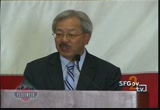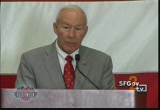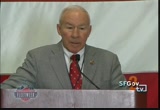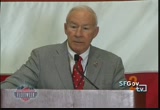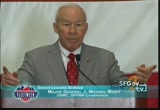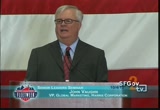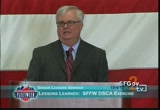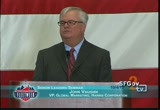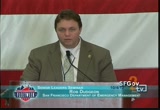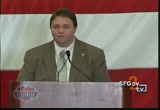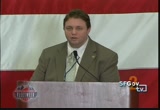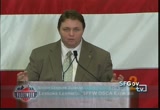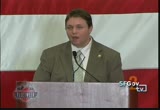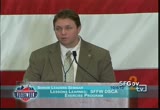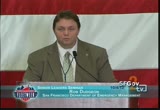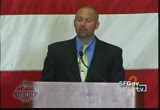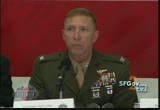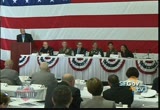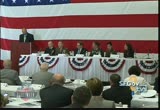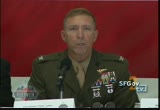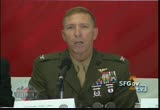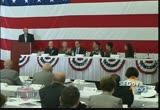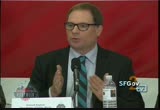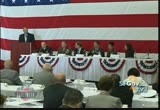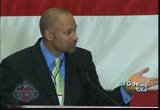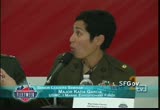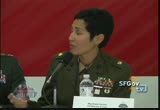tv [untitled] November 3, 2012 12:30am-1:00am PDT
12:30 am
angels and the parade of ships but i think the public will appreciate even more how ready we are and the practice we are doing. thank you very much. again, i salute the men and women in uniform that are here to help us, that are here to practice what we preach and again also to all the different agencies that are working together with us. thank you very much for being here, happy fleet week. . >> when people ask me about our mayor, i tell them, he gets it. you can see that from his remarks just now. he knows what this is about. and a lot of other people get it, too, and i want to tell you after fleet week the senior leaders seminar last year, the word got around. and in november there was a massive earthquake in have an, turkey, and the city of san francisco and the san francisco
12:31 am
fleet week association were asked to send a team to do an assessment of their earthquake and their preparations or lack of preparation. so the word is getting out. seattle invited us to come up and talk to them about incorporating that, this program, into their fleet week. so the word is getting out. i'd like to tell you just a story that i've told before to some of you but it relates very much to the next panel that we have here. back in april of 1992, i was commanding the first marine division and we had been to the gulf war and we had a lot of parades and we were feeling pretty good about things and on 30 april, 1992, the results of the rodney king trial were announced. two days later, we found the first
12:32 am
marine division deployed to compton and watts and one of the most horrific sights i'd ever seen. it was the largest riot in u.s. history. 3,000 people were injured, 60 people were killed, and we actually ended up at one point in time having to use live ammunition. but once we did, the bloods and the krips and the gangs there realized we were serious. the reason we got involved is because they learned none of the police departments within los angeles could talk to each other on their communications gear. they had a different piece of equipment in the los angeles county sheriff's department than the police department or the compton police or the watts police or whoever. we ended up, we were
12:33 am
providing radios so they could talk to each other. and i said that that should never happen again. we should have interoperatable communications. there's some that say we aren't any better off today than we were in 1992. we don't know, but we had an exercise, part of this fleet week preparation exercise, put on by the department of emergency management and it involved a lot of various agencies and we looked at the command of control situation and the command of control situation was an important one because you realized in 1992 the situation got so grim that the governor of the state then asked dod to take it over. so our chain of command went from my headquarters at the 7th infrapb tridivision headquarters right back to the
12:34 am
pentagon. we said that should never happen again. so we looked at command of control relationships in this exercise. so we're going to bring up the next panel and this exercise was conducted in august and we're going to take a few minutes to get the panel up here and we'll have the panel moderator introduce us, john vaughan from harris, but if any of you need to make a head call, behind these screens we have men and women's heads, restrooms for those of you who don't know the term. behind those screens. rich is telling me i'm going back wrong end of the ship, back that way behind the screens, so feel free to go back there. so let's take a few minutes
12:35 am
now and bring the panel up and the panel moderator, john vaughan thank my name is john vaughan, i'm from harris corporation. we're delighted a sponsor again this year of san francisco fleet week. our focus, if you had an opportunity to see on the way in the demonstration, is on interoperatability. this has been a challenge as lts general just mentioned. in the past we have been blocked in interoperatability by the use of different frequencies, by the use of different digital formats and been challenged in a number of different ways. i guess since those days there has been one important improvement, one technological improvement, that we use
12:36 am
expensively to create interoperatability and that is ip networks built of sdparate systems and the network allows us to operate. as you see from our demonstration as you checked in this morning, as you ridge stered this morning, san francisco talking it oakland, talking to this ship, talking over cellular, talking across and with different networks. the challenge for interoperatability is beginning to be met, i would say, the challenge for interoperatability at the same time is about to get much greater. we as a nation are about to embark on the most ambitous, most challenging communications endeavor that we have ever attempted, which is the creating of purse net, the public safety broad band or 4g network. and with that brings
12:37 am
the promise of new challenges for sure in interoperatability and new capabilities that we have never had before. in fact, no other country is as far along as we are, even though we're just starting. what we see is the opportunity there to interoperate in many different ways than just voice as we have in the past. the challenge for us in the future will be the challenge of connectivity where we can connect wide band or narrow band voice or data or video across different systems. again, all of this is based on using internet protocol. one of the things that we at our company does is provide a relay in an unmanned vehicle to fly in the vicinity of a ship like this and provide over the horizon communications. very
12:38 am
high level communications. but importantly, it also integratings and interoperates narrow band, broad band, voice, data and video. and so the challenges of the new systems that are coming out and will be coming out over the next few years are great, but so are the benefits. we know the technological answer, as i mentioned, is ip, internet protocol. but i suggest we might use those initials for two things that are equally important as an introduction to this panel. one is, as we've already heard, is interpersonal. ip also stands for enter personal and those relationships are very important as we have heard here. the other thing is the importance of planning. the planning that's also going on and as you will hear in a few minutes from the panel, is extremely important. i thank you for your attention and at
12:39 am
this point i'm going to turn the panel over to rob dudun to introduce our panel members. >> good morning, i feel a little bit like the opening act at a show here. so we're going to see where this goes. i have a really, really good panel for this one. because i get to talk about what we've done. and i get to have these guys up here, i'm going to hand off to my no. 2, vijon karemi, and we're going to have a discussion. my job is to tell you how we got here. that's what i'm going to try to do. some of you know the history, some of you are new to the process, but that started about the idea that general myat and the mayor talked about. let's make this more than an air show. in 2010 we did this senior leader seminar and the first
12:40 am
thing we did was let's talk about how we relate formally. that was, i like to call that the wire diagram year because we all sat up here and we had local, state, federal and military and we walked through how each of us relates, what are the limitations, what are the laws, what are the rules of engagement, how do we actually work together? and that sets the stage for everything that has come beyond that. the big exchange of information at a very high level and it quickly led to the conclusion we all understand the policy of it, but as was the case in a lot of situations, we don't get past the diagram. we don't get past the policy page and the wire die agrams and if we want to make this meaningful we need to get past the next level and we need to start stretching the boundaries and start talking it each other in as close to real
12:41 am
world situations as we can so we each understand how the other operates, what the limitations are, what the boundaries are, and from there we can start to grow as institutions and try to make this institutional knowledge and not just individual relationships. so in 2011, we took it to the next step and we took a table top and we picked medical surge. a lot of people looked at that and said, well, there's there's this and there's that and the military comes in much later than everybody else and all that's true. as we look at this panel and look at the scenarios for this year, i'm going to say the same thing i said last year. look beyond the scenario. what we're looking at is how do we relate, how do we work together. that's what this is really about. in my opinion it is incumbent upon us as a local community to understand where our gaps, are
12:42 am
understand what we will need in a time of crisis and understand how best to dovetail with the resources coming in. the military does what the military does and they can be incredible flexible. they can bring a lot of stuff to bear that we can never even imagine. it's our job to understand where those hard stops are for them and how they are best suited, because we can build out our plans in anticipation of that. in the case of, say, medical surge, we can look forward and say this is what we're going to need. we're going to need help with patient movement. we're going to need help with the chronickly ill because by the time the military arrives, a day or so into it at least, even with the best of plans, we're going to have to start figuring out how do we manage those chronic patients and you know what, moving stuff is what they're really good at. moving patients in particular, they
12:43 am
are amazing. so we start to look at things like that. as we look through this and we start to talk, remember it's beyond the scenario, it's the relationship. this year we decided to test, based on last year's lessons, last year the table top on the broad topic of medical surge, generated a top of lessons learned. a lot of areas to explore. one of the biggest ones was, here's a surprise for you, interoperatable communications. it always works out that way. the other was command control. how do we operate together at the field level. it's one thing to have all the executive staff working together, it's another thing to take our middle managers from all the organizations and throw them into a situation where they have to work together. because the way we work together on the civilian side and the way you work together on the military side is slightly different. but we're all very intelligent individuals out there and they
12:44 am
know how to solve problems. again, it's our job to understand what the limitations are. it's our job to understand that what is given in terms of giving an asset an order and we may look at it and say, hey, things change, we need to go over there now. that may or may not be something our military counterparts can do. we have to understand that. we have to understand that in order to maximize the efficiency and efficacious of that resource. this year we did a command of control exercise and we did a communications drill and we did them simultaneously. they were sort of related, sort of not. one was, we brought out the coms people and said, play, we set up 3 points around the city and said play, make this stuff
12:45 am
connect. see if we can talk to each other. we had the national guard above us in a helicopter, even though it was really foggy, they didn't see much, but they demonstrated proof of concept that they can connect the video feed. we learned there are limitations in things of band width and video feed that i'm not qualified to talk about, i'm strictly a push to talk guy. we know as a city when the earth moves, things fall, we get a lot of rubble. that's going to be one of our critical, critical things we have to do. we have to be able to move material and personnel and one of the ways we're going to be doing that is how do we actually get the debris off the road so we can put things back to work. so that was the command of control exercise. we had the marine corps, the navy, and the national guard all working with our department of public works figuring out
12:46 am
how would they work together. we didn't give them a lot of coaching, we just kind of put them in a tent and said here is your scenario, here's some problems, and we wanted them to work it out and they did. so it was a very successful year. that's what we did as far as the field exercises. next year i don't know what's next, we're going to explore the lessons learned from this one, we've already learned a bunch, they're going to talk about this shortly then learn what are the next scenarios we can challenge people with. it probably won't be the same ones. we are building the institutional relationships and getting beyond the scenario. it's not just about the heavy equipment operators, it's about city of san francisco staff and departments understanding how the military works and giving the military a chance to work with the civilian authority in a non-crisis environment so that when they have to do it anywhere in the world, they've got one extra training day.
12:47 am
that's the way we look at it, it's all one extra training day. you add all that up, we have a lot better chance when we need it. with that, i'm going to bring up dejon and take over the panel and i'll talk to you shortly. >> thank you, rob. the panelists we have represent a broad group of participants, some of them participated themselves and some of them had individuals in their organizations participate. and i want them to start with an introduction of who they are, a little bit about their own background, so you understand the lens they were looking through when they were providing some of their answers today. starting with our 3 panelists that were part of our command and control exercise then we'll hear from our 3 panelists that were in our communications drill. >> lieutenant commander mike kress, operations officer at naval beach group 1, i was a coach during the exercise. we
12:48 am
supported the exercise with 3 subject matter experts from amphibious construction battalion 1, their expertise is in route clearance, they actually played in the exercise and i was the coach for the exercise. >> good morning, i'm colonel alley, marine operations officer for the marine expedition briged. i was responsible for the planning and (inaudible). >> good morning, my name is (inaudible), superintendent pe department of public works, i'm responsible for street cleaning, trees, landscaping through the city. on the day of the incident i was the operations chief at the incident command poach at ocean beach. >> good morning, i'm captain houston with the california
12:49 am
national guard. i'm with first marine briged. i've been coming to san francisco since may for the planning efforts and i got to participate in the com drill with 6 marines and we were dispersed from all 3 different sites. >> good morning, everybody, my name is michelle geddis, i'm with the san francisco department of emergency management, i'm responsible for the project management ofrs and one of our major programs is the interoperatability program. so i was more than delighted to be part of this com exercise, i was able to be an evaluator at the ocean beach location and we have a lot of lessons learned to talk about. thanks. >> one of the challenges that we have in civilian and also you as military is that common operating picture. how do we make sure that all of our
12:50 am
resources in the field, back in the command post, have the same operating picture and we can ensure that we have an unity of effort of everyone. and with the command and control exercise that we started with, this was one great opportunity for the military and the civilian groups to work together. so i'd like to hear from our c2 exercise participants how that went. colonel jolly, will you tell us about that? >> from our perspective we had the right people in the right place. as we saw during the medical exercise yesterday, ocean beach has a good many advantages for both the city of san francisco and for the military to facilitate disaster relief. i would say during the exercise also as many people have pointed out, building relationships was the highlight of the day and the planning process. we learned a lot about each other, capabilities and processes. i would also say that during
12:51 am
the day we focused on how a command post should operate. within the marine corps and the military, we talk about commander's sbept. that gets us past the flow chart diagram or the policy question, it gets to what truly is the outcome that the commander or the mayor in this case is looking for, and that allows everybody in the room to think beyond just the specific problem but to more the holistic solution to the outcome that we're looking for, in this case route clearance. we talked about how to filter information that comes into the coc my experience in disaster relief is the amount of information coming into a command post is overwhelming so processes have to be put in place so that the filter allows emergencies to be addressed appropriately, priorities to be resourced appropriately, and the routine to be put into
12:52 am
something so that everyone is aware of it and if it becomes, it changes to one of the other categories it can be addressed. and, last, we talked about how to share that information not only amongst ourselves within that particular command goes, but across the city, outside of the city up to the state and further if resource shortfalls do occur. we talked about a mapping process but more importantly than just that process, really the -- go back to my first point -- is the intent. if we start with a plan that explains what the priorities are, everybody is focused on those priorities. so if the map shows those critical pathways that have to be opened, which i saw yesterday during the medical exercise, the medical community knows what those routes are, they know which one have to be opened in order for citizens to get to those critical places. once that's posted up in the coc, we're all focused on that
12:53 am
priority. identifying where those challenges are is really the challenge to understand that command element, command post, what the priority is and to be able to transmit that to the field where the resources are and then, if need be, to transmit the resource shortfalls beyond that. overall it was an outstanding experience. >> i'll jump in here. so this concept of common operating picture is one of the biggest takeaways for me and i think the city as we did this exercise. now, big concept, easy to implement. as rob was talking about, we're out at ocean beach, we're in a tent, we're 72 hours in, we don't have a lot of equipment, all i really needed to have was a nice map and to bring everyone to that map so we would have that common operating picture so everyone understood what we were doing. two things that were brought to me when we did our after
12:54 am
action talk. one was a shared mission. folks in the military, it was clear to me, and we had a great working relationship, they are going to do what we need to do from jump street. they are just going to make it happen. but it would have been important to me, i could have used that vehicle, the common operating picture, to show what that mission was. why are we clearing specific routes? we often in the city jump right into our projects, we do this day in and day out, i know which routes have to be cleared, but if i had used the common operating picture down at ocean beach and showed them from the military why we were clearing certain routes, again we would have gotten it done. it was brought to my attention to do that, to have the setting, it talk about the common operating picture so we can all see it, then we started to breathe at that place. it changed everything. one of the
12:55 am
biggest things for me that i went back to, i need that in my go bag, in my package as i go out to an incident is make sure i have something that works for everyone, not just the city folks, but everyone there working with me on the ground. >> i don't have much to add to that. i agree 100 percent with all that. that was probably the common operating picture was probably where we got our, most of our lessons learned from. if we had updated that a little bit better, we would have been able to track the resources a little bit better. we would have been able to allocate them a little bit better, and i was pushing my guys to actually add more information into that common operating picture so any time anybody came into the incident command post, whoever walked in there could ipbs stabilitily get awareness of what people were where, what equipment is
12:56 am
being used and where, how long it's been there. that was our biggest lesson learned and we've taken steps to ensure we use it in the future. >> as rob mentioned, concurrently but not connected was the communications drill. like rob, when i key up my radio i just expect it to work and when it doesn't, i'm not quite sure what to do. that's why when we bring in the communications experts they are the ones who are going to make all the different systems talk to each other. and a lot of the grant money that we receive in the bay area is for interoperatability, getting all the radios for all the different emergency responders to work together. and in the exercise we did in 2011, when we were discussing the medical surge, a lot of times we would just kind of wave our hand and say, oh, yeah, people will talk together and the people why we really wanted to seize on that was let's see if we can actually do
12:57 am
that. and that's why we ran our communications drill. the idea was to connect voice, video, radio and data back and forth to see if we can talk back and forth. one thing i learned was we brought the military on to the city's network. one of the things i look forward to next time is having us go on to the military network because it's highly likely our city network will be down, so we will be relying on them. so from our communications participants, you encountered some challenges but you were able to work through those. i'd like to hear from you, what were some of the challenges you ran into and how were you able to overcome them and i'll start with major garcia. so one of -- we're going it talk about challenges but also the good things. i want to mention that throughout this planning effort we've been planning since may but we literally got on the ground probably monday, most of us,
12:58 am
and then on tuesday we threw all our equipment into different sites and turned it on and we had connectivity, one way or the other. i think one of our challenges, i know for my group, i was out at pier 96, we were supposed to connect into the data network and my marines had a very small footprint, small suitcase, we weren't able to actually connect to the cloud and be able to send reports via web voc using an ip network. the good thing, however, how we overcame that challenge and i think it was a very good planning consideration, was that at each of the sites we had an element either from the national guard or air national guard or the department of public works acu one thousand van and they pretty much made up the backbone of that network. the point i'm trying to make is we had redundancy at each
12:59 am
site and then small unplanned events were not a factor. one way or another we were able to send our reports through. this is a starting point for working in san francisco. we could have probably done more analysis of the terrain that we're working in terms to identify those black holes for cops, those black areas. so we learned a lot. i think a lot of this has been captured in the afteraction and i think if we have another iteration next year to definitely have a good starting point. >> we brought from the california national guard, we brought our quick reaction area force and we brought our ic for you so we had 3 different com spans that are cross banded, which is an opportunity that not all dod assets have.
78 Views
IN COLLECTIONS
SFGTV2: San Francisco Government Television Television Archive
Television Archive  Television Archive News Search Service
Television Archive News Search Service 
Uploaded by TV Archive on

 Live Music Archive
Live Music Archive Librivox Free Audio
Librivox Free Audio Metropolitan Museum
Metropolitan Museum Cleveland Museum of Art
Cleveland Museum of Art Internet Arcade
Internet Arcade Console Living Room
Console Living Room Books to Borrow
Books to Borrow Open Library
Open Library TV News
TV News Understanding 9/11
Understanding 9/11